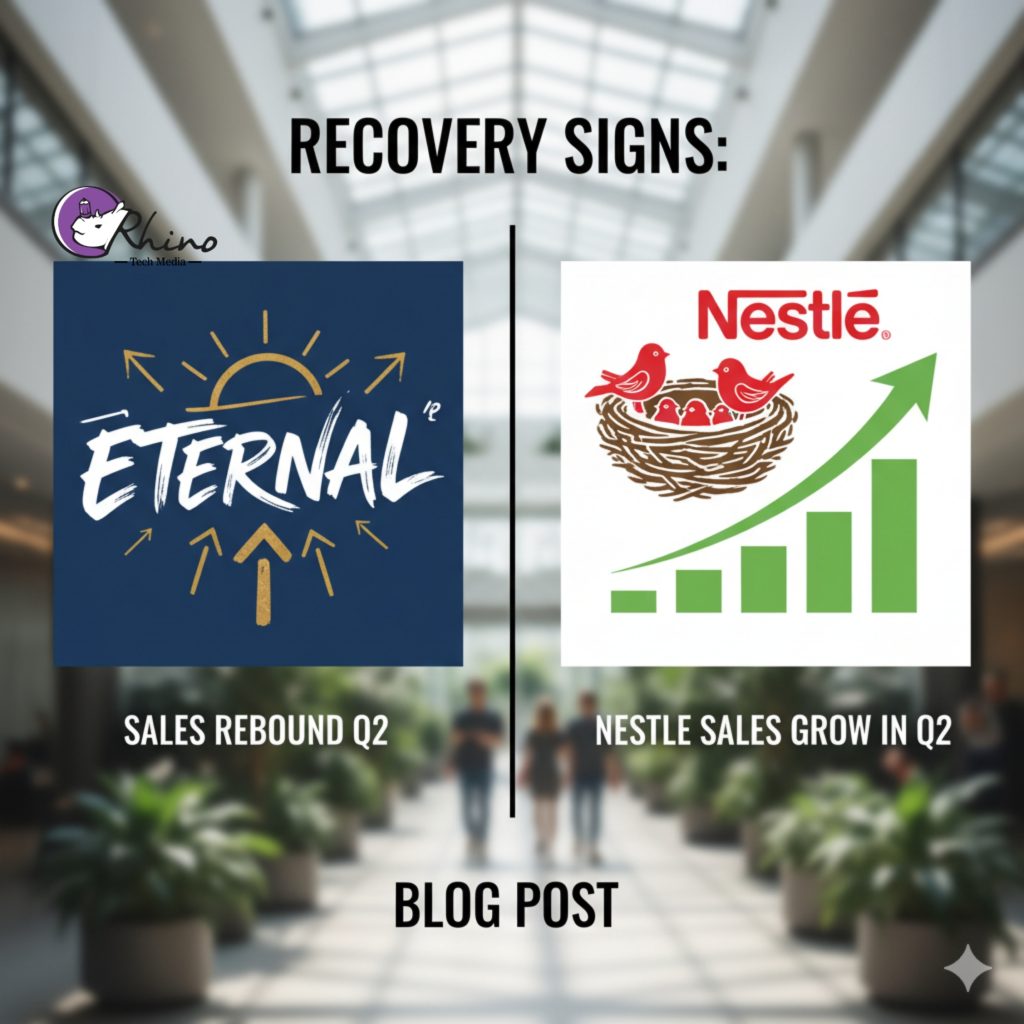Introduction
The second quarter (Q2) results released by consumer-facing companies Eternal (formerly Zomato) and Nestle India have drawn attention as possible early indicators of a broader recovery in demand. After a period of weak urban consumption and margin pressure on account of elevated input costs, these results suggest that growth is returning—albeit unevenly. While both companies saw solid revenue growth, profitability remains under stress. In what follows, I examine their performance in Q2, highlight the recovery signals, assess the risks embedded in the results, and sketch out what lies ahead.
Q2 Performance: Eternal and Nestle
Eternal (formerly Zomato)
- Eternal’s revenue from operations in Q2 soared to ₹13,590 crore, representing a 183 % year-on-year increase from ₹4,799 crore a year ago.
- However, net profit tumbled by 63 % YoY, down to ₹65 crore from ₹176 crore in the prior year period.
- On a sequential basis, profits did improve (from ₹25 crore in Q1 to ₹65 crore).
- The revenue surge was driven largely by the quick commerce arm (Blinkit), which posted a 137 % YoY increase in net order value (NOV), with the number of dark stores doubling to 1,816 in the quarter.
- The food delivery vertical also showed recovery: food delivery revenue grew ~22 % YoY and sequentially as well.
- However, margins remain under pressure. Adjusted EBITDA fell by ~32 % YoY, though it improved vs. the prior quarter.
- Management cautioned that though the growth trajectory is improving, it will likely be gradual. They flagged soft discretionary spending, intense competition in quick commerce, and weather volatility as headwinds.
Thus, for Eternal, while the topline growth is dramatic, the challenge remains to convert that into sustainable profitability.
Nestle India
- Nestle India’s revenue from operations in Q2 rose by 10.6 % YoY, reaching ₹5,643.6 crore—its highest-ever quarterly sales.
- Domestic sales grew ~10.8 % YoY, driven by strong demand across product categories including Maggi, Nescafé, confectionery, and cooking aids.
- Yet, net profit (standalone) declined by ~24 % YoY, to ₹753 crore (vs. ₹~990-ish a year ago).
- The drop in profit is largely attributable to rising raw material costs (cocoa, milk, edible oils) and higher operating expenses.
- On the plus side, broad-based demand recovery and double-digit volume growth in many product lines reflect that consumers are returning to purchase staples.
- Analysts point to potential margin pressure in future quarters but see upside in the volume rebound and pricing flexibility.
In sum, Nestle’s results show that its core business is seeing healthier traction; the softness in profits is more a function of cost pressures than demand weakness.
Recovery Signals and Their Significance
From the above, several recovery signals emerge:
- Revival in consumer demand
Both companies saw meaningful topline growth in Q2. For Nestle, this suggests that after a protracted slowdown, staple FMCG consumption is regaining momentum. For Eternal, the strong growth in food delivery and quick commerce indicates renewed willingness among consumers to spend in discretionary segments (albeit with caution). - Volume-led growth alongside pricing resilience
In Nestle’s case, many segments showed volume growth rather than purely price-driven gains. That bodes well because relying solely on pricing is unsustainable over time. - Operational improvement and scale effects
For Eternal, the narrowing of losses in Blinkit (its quick commerce arm) and sequential improvement in profitability reflect that the scale effects and efficiencies might be kicking in. - Sequential momentum is positive
In both cases, the sequential progression is important. Eternal’s profits jumped sequentially; Nestle showed improving trends even with cost headwinds.
These signals are meaningful: they point to a gradual, nascent recovery, rather than a sudden rebound. The underlying consumer psyche remains cautious, and margins will remain a critical battleground.
Risks and Caveats
While the growth is encouraging, the results come with caveats:
- Margin squeeze: The biggest risk is the escalation of input costs (cocoa, coffee, milk, edible oils). For Nestle, these have already eaten into profits. For Eternal, margins are thin in the quick commerce business, and any cost overruns could erode gains rapidly.
- Consumer spending volatility: The rebound is fragile. Any external shock—macroeconomic slowdown, inflation resurgence, weak rural recovery—could derail momentum.
- Intense competition: In quick commerce and food delivery, competition is fierce, and players often sacrifice margins to gain market share. Eternal will need to balance growth with unit economics.
- Tax / regulatory shifts: For example, changes in GST, duties on imports (coffee, edible oils), or regulations affecting digital commerce could upset the balance.
- Base effects and comparisons: A strong YoY growth might partly reflect weak base quarters. Sustaining that growth into future quarters will be tougher.
Thus, while recovery signs are there, they must be interpreted cautiously.
Forward Outlook
Looking ahead:
- For Eternal, the focus will be on improving unit economics in quick commerce, scaling efficiently, and stabilizing margins. If the company can deliver consistent sequential profit improvement while retaining growth momentum, it can validate the turnaround thesis.
- For Nestle, managing raw material cost volatility while leveraging volume growth will be critical. Continued investment in distribution reach, premiumization, product innovation, and brand strength will help insulate margins.
- More broadly, if Q3 and Q4 continue to show positive trends across FMCG and consumer discretionary sectors, the narrative of a consumer-led recovery will gain traction in the market.
- Investors and analysts will watch management commentary closely for forward guidance, margin expectations, inflation trajectory, and strategies around rural demand.
Conclusion
The Q2 results of Eternal and Nestle indeed send tentative but meaningful signals of recovery in consumer demand. Eternal’s dramatic revenue growth and narrowing losses, and Nestle’s robust volume-led sales jump, suggest that the worst of demand weakness may be behind us. Yet, the road ahead is fraught: rising input costs, competitive pressures, and macro volatility could pose serious challenges to turning this revenue growth into healthy, sustainable profitability.

